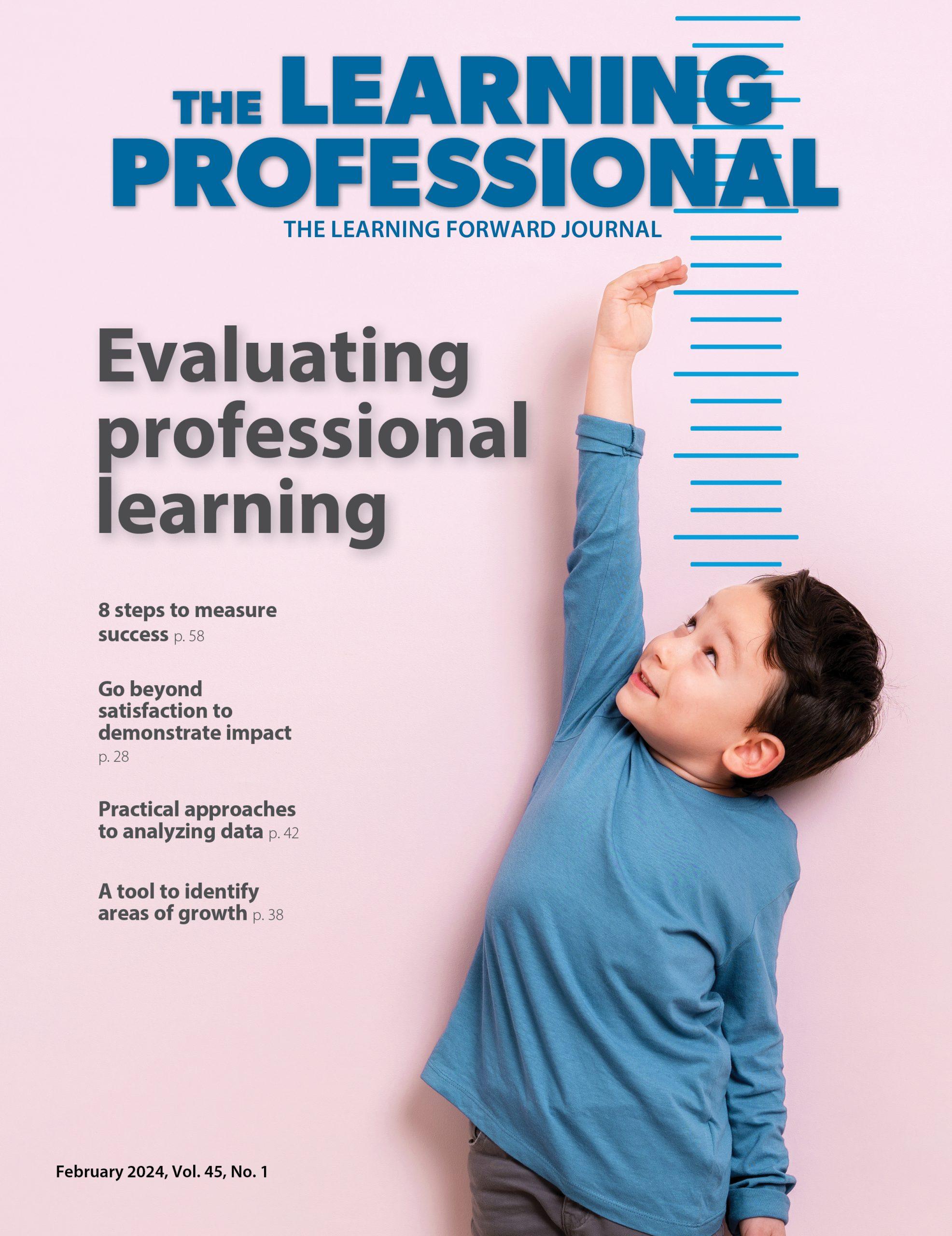IDEAS
How principals can ensure that every student succeeds
By Suzanne Bouffard
Categories: Career pathways, Data, LeadershipApril 2024
Ensuring that every student succeeds takes a shared commitment among all adults in a school and the system that houses it. Principals play a key role in leading and modeling that commitment. Through instructional leadership, professional learning, interactions with colleagues and students, and many other responsibilities, principals can prioritize equity and establish expectations and processes for their colleagues to address every student’s needs.
This commitment to equity cannot be a standalone initiative or an add-on task, but instead should be woven into the fabric of leadership and into the school as a whole. As Learning Forward (2020) has articulated in its equity position statement, students’, teachers’, and leaders’ experiences are interconnected.
Because leadership is a cornerstone of an equity-focused system, The Wallace Foundation commissioned a group of experts to review the research and scholarship on culturally responsive leadership and consider how to integrate it within principal development and support structures, such as those the foundation has helped to flourish. The research illuminates what principals need to ensure all students succeed, and high-quality, standards-aligned professional learning plays a key role.
A principal's commitment to equity cannot be a standalone initiative or an add-on task, but instead should be woven into the fabric of leadership and into the school as a whole. #EdLeadership #TheLearningPro Share on XA learning-centered system for developing principals
From 2011 to 2017, Wallace supported six large school districts to develop comprehensive, aligned principal pipelines — intentional, research-grounded approaches to identify, recruit, develop, and support school leaders. Accompanying research identified the following seven key elements, or domains, of principal pipelines that not only result in stronger leadership but also higher student achievement (Gates et al., 2019, 2020):
- Leader standards that delineate what principals should know and be able to do.
- Preparation programs for aspiring principals and assistant principals.
- Selective hiring and placement of principals.
- On-the-job professional learning, support, and evaluation.
- Principal supervision processes that include hiring, supporting, and evaluating principal supervisors.
- Leader tracking systems to monitor and connect preparation, hiring, support, and evaluation.
- Sustainable systems of support that include a district-level position or office responsible for school leadership.
Because learning happens throughout the pipeline, and throughout a principal’s career, professional learning and support are integral across the domains. And that learning happens in multiple contexts, not just in the principal’s office. As the graphic below shows, multiple stakeholders and institutions play a role in building principals’ capacity, including schools, districts, and higher education.
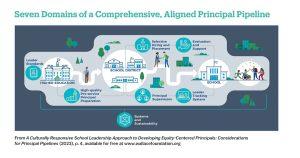
Building equity into the pipeline
The commitment to leaders’ continuous learning throughout the pipeline provides valuable opportunities for principals to expand their understanding of and capacity for equity-centered leadership. To highlight those opportunities and provide guidance on how to leverage them, Wallace turned to a team headed by Mark Gooden and Muhammad Khalifa who, with James Earl Davis, had created the influential Culturally Responsive School Leadership framework (Khalifa et al., 2016).
Gooden, Khalifa, and team produced a report that connects the framework with the domains of the principal pipeline (Gooden et al., 2023). It can help systems and individuals cultivate principals’ equity mindsets and practices in a way that is integrated and integral to strengthening the workforce and its positive impact on students overall.
- Gooden and colleagues describe how the seven domains of the principal pipeline can be infused with the following equity-centered practices from the Culturally Responsive School Leadership framework:
- Develop critical consciousness about historical oppression and current school conditions and resources.
- Ensure inclusive school environments that are welcoming and culturally affirming through active collaboration with historically and currently marginalized people.
- Provide culturally responsive instructional leadership for teachers to support them in honoring the knowledge, contributions, and ways of engaging people of color and challenge systems that marginalize people and communities.
- Enact culturally responsive leadership engagement in community contexts by establishing partnerships with families and the community at large.
The components of this framework can be integrated into all aspects of principal pipelines in multiple ways, as the authors of the report show. The table below highlights some of them.
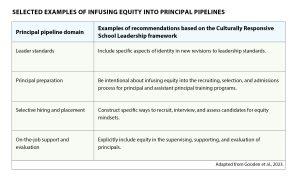
Professional learning that embodies equity
For principal pipelines to be equity-centered, principals’ professional learning should not only address equity but embody and reflect equity. Learning Forward’s Standards for Professional Learning, which describe the content, processes, and conditions for high-quality professional learning, address equity explicitly and intentionally (Learning Forward, 2022a). All standards are grounded in the goal of “equitable and excellent outcomes for all students,” and three standards home in on equity as a feature and a topic of professional learning: Equity Foundations, Equity Drivers, and Equity Practices. (See table, below.)
The full set of standards helps to disrupt and dismantle inequities, as articulated in the equity position statement (Learning Forward, 2020), through multiple mechanisms that include eliminating gaps in access and opportunities by ensuring high-quality teaching, leading, and learning and equipping educators with knowledge and strategies specifically designed to recognize and eliminate bias in the classroom and in their own instructional practices.
School and system leaders play especially important roles in implementing the standards in general and the equity standards specifically. For example, the Equity Foundations standard points out that leaders “have primary responsibility and autonomy to establish conditions, structures, and cultures that put equity at the heart of professional learning” (Learning Forward, 2022a, p. 56). When they set the table for equity, leaders make it possible for educators at all levels “to contribute to such conditions through how they engage, respond, and make explicit their expectations for themselves, their peers, and the leaders who support them” (Learning Forward, 2022a, p. 56).
The equity standards show how professional learning can be an avenue for enacting the equity-centered work recommended by Gooden and colleagues, especially the recommendations in the pipeline domain of on-the-job support.
For example, a recommendation for developing critical consciousness includes engaging in personal identity work to examine biases, assumptions, and mental models. Professional learning provides one avenue for engaging in that work, and the Equity Drivers standard points to educators’ identifying and addressing their own biases and beliefs as a component of high-quality professional learning.
The recommendation to nurture inclusive school environments asks educators to “support and evaluate principals’ efforts to build relationships with teachers and students, and to challenge current practices that marginalize students based on race, gender, social class, sexuality, ability, immigration status, language, and religion” (Gooden et al., 2023). The Equity Practices standard mirrors this intention by encouraging professional learning leaders to make space for exploring and embracing student assets through instruction and strategies for fostering relationships with all students, families, and communities.
The focus on nurturing culturally responsive instructional leadership describes the need for school leaders to support the development and implementation of a vision of equity-focused instruction. Similarly, the Equity Foundations standard includes educators setting expectations for equity and structures of equitable access to learning, both for educators and students.
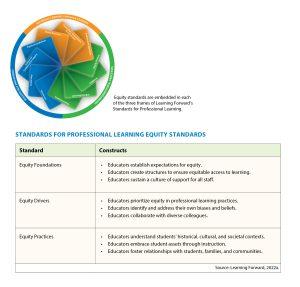
Furthermore, recommendations for culturally responsive school leadership that makes learning accessible to all students requires high-quality professional learning about pedagogy and curriculum. The Curriculum, Assessment, and Instruction standard dovetails with the equity standards to provide guidance on how to support all teachers and other educators to ensure rigorous learning for all students.
The Standards for Professional Learning apply to all educators, including principals and those they supervise as well as principal supervisors, who are a key part of principal pipelines. Learning Forward has created role-specific action guides that provide step-by-step guidance for implementing each standard. They include Innovation Configuration (IC) maps, which show how to get from entry to ideal implementation of each standard. See example below from a portion of the Equity Drivers standard as it applies to the role of principal.
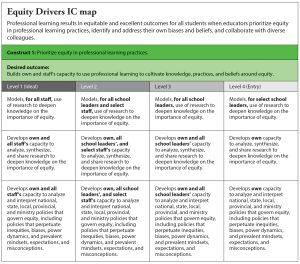
Systemwide commitment to growth
When professional learning is designed with equity in mind, it can be a powerful tool to build principals’ capacity to support each and every student to high achievement. High-quality, equity-focused professional learning can be embedded at every stage of the principal pipeline, especially when those who supervise and support principals are also engaged in learning. That systemwide commitment to growth can build everyone’s capacity for culturally responsive leadership and instruction so that every student is seen, supported, and successful.
Download the PDF here.
References
Gates, S.M., Baird, M.D., Master, B.K., & Chavez-Herrerias, E.R. (2019). Principal pipelines: A feasible, affordable, and effective way for districts to improve schools. RAND Corporation.
Gates, S.M., Kaufman, J.H., Doan, S.Y., Tuma, A.P., & Kim, D. (2020). Taking stock of principal Source: Learning Forward, 2022a. pipelines: What public school districts report doing and what they want to do to improve school leadership. RAND Corporation.
Gooden, M.A., Khalifa, M., Arnold, N.W., Brown, K.D., Meyers, C.V., & Welsh, R.O. (2023). A culturally responsive school leadership approach to developing equity-centered principals: Considerations for principal pipelines. Wallace Foundation.
Khalifa, M.A., Gooden, M.A., & Davis, J.E. (2016). Culturally responsive school leadership: A synthesis of the literature. Review of Educational Research, 86(4), 1272- 1311.
Learning Forward. (2020). April 2024 | Vol. 45 No. 2 Learning Forward’s equity position statement. lfstage.xyz/2020/10/14/learning-forwards- equity-position-statement/
Learning Forward. (2022a). Standards for Professional Learning. Author.
Learning Forward. (2022b). Action guide for the principal: 43 Implementation strategies and Innovation Configuration maps for Standards for Professional Learning. Author.

Suzanne Bouffard is senior vice president of communications and publications at Learning Forward. She is the editor of The Learning Professional, Learning Forward’s flagship publication. She also contributes to the Learning Forward blog and webinars. With a background in child development, she has a passion for making research and best practices accessible to educators, policymakers, and families. She has written for many national publications including The New York Times and the Atlantic, and previously worked as a writer and researcher at the Harvard Graduate School of Education. She has a Ph.D. in developmental psychology from Duke University and a B.A. from Wesleyan University. She loves working with authors to help them develop their ideas and voices for publication.
Categories: Career pathways, Data, Leadership
Recent Issues
LEARNING TO PIVOT
August 2024
Sometimes new information and situations call for major change. This issue...
GLOBAL PERSPECTIVES
June 2024
What does professional learning look like around the world? This issue...
WHERE TECHNOLOGY CAN TAKE US
April 2024
Technology is both a topic and a tool for professional learning. This...
EVALUATING PROFESSIONAL LEARNING
February 2024
How do you know your professional learning is working? This issue digs...









